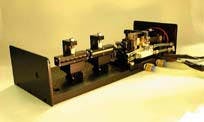Incorporating news from O plus E magazine, Tokyo
LONG-WAVELENGTH SOURCESSENDAIResearchers at the Riken Photo-Dynamics Center have developed a terahertz laser light source that is tunable over a wide range of frequencies. Terahertz light falls in a frequency range between radio waves and light waves; for electron-circuit-based transmitters such as those for ham radios, terahertz radiation is in an ultrahigh-frequency region, while for laser light sources, this frequency range is in an ultralow-frequency region. Because of this in-between nature, the terahertz region has not been investigated thoroughly in the past.
Based on a nonlinear optical magnesium oxide:lithium niobate crystal, a compact terahertz light source generates wavelengths of from 110 to 460 µm. (Photo courtesy of Riken Photo-Dynamics Center)
The system is of tabletop size (see figure). To generate terahertz light efficiently at room temperature, optical parametric generation is combined with injection seeding to extract light of the desired frequency. Tunable terahertz light sources already exist in places like the University of California at Santa Barbara. Because the university's free electron laser is a large-scale instrument that is more than 10 meters long, however, the number of users is limited. In addition, the terahertz light sources in standard use in the United States and Europe are femtosecond laser-pulse-excited light sources ranging from very low frequency to several terahertz, which means the radiation has an extremely broadband spectrum.
In this experiment, a nonlinear photonic magnesium oxide:lithium niobate crystal is positioned longitudinally and a silicon prism array is fused to it to produce terahertz light efficiently. The pumping laser is a 1.064-µm-emitting Nd:YAG laser, and the seeding laser is a 1.067- to 1.074-µm external resonator semiconductor laser.
The output is 300 W300 times the conventional output. In addition, the width of the oscillation spectrum (an indication of the pureness of the frequency) is 100 MHz. This is the theoretical limit, and 10,000 times better than previous figures. The tunable frequency range of this device is 0.7 to 2.7 THz, which when converted to wavelengths is a very wide 110 to 460 µm. The footprint of the system is only 50 cm2.
Given the successful development of this laser, the group hopes to pursue various areas of study, including basic research such as molecular and condensed matter spectroscopy and live body research, and applied study such as quality assessment of various materials.
Courtesy O plus E magazine, Tokyo
